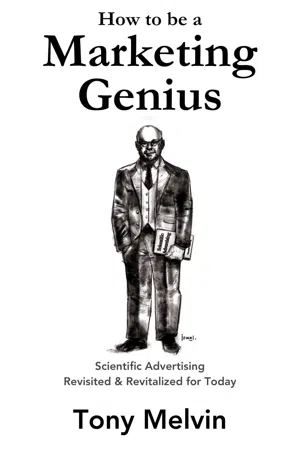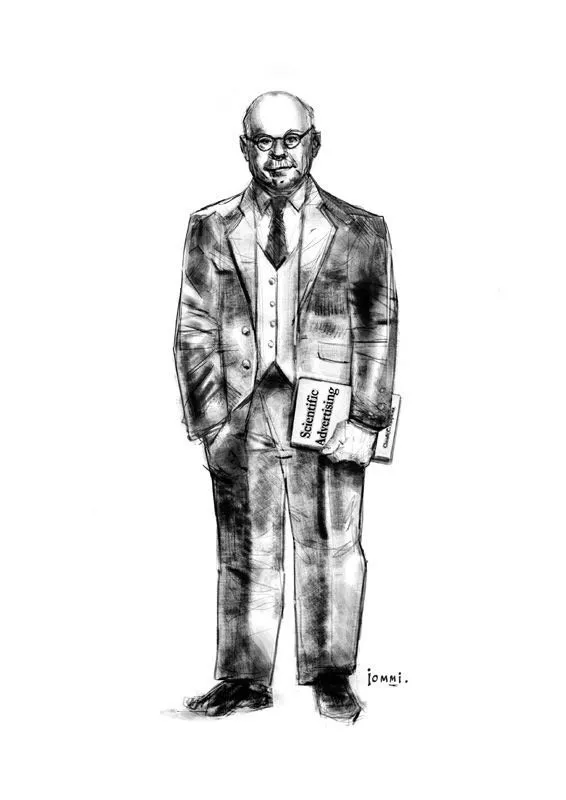![]()
PART ONE:
SCIENTIFIC ADVERTISING
BY CLAUDE HOPKINS
![]()
1
HOW ADVERTISING LAWS ARE ESTABLISHED
THE TIME HAS come when advertising has in some hands reached the status of a science. It is based on fixed principles and is reasonably exact. The causes and effects have been analyzed until they are well understood. The correct method of procedure have been proved and established. We know what is most effective, and we act on basic laws.
—— FUNDAMENTAL LAW ——
The time has come when advertising has in some hands reached the status of a science. It is based on fixed principles and is reasonably exact.
Advertising, once a gamble, has thus become, under able direction, one of the safest business ventures. Certainly no other enterprise with comparable possibilities need involve so little risk.
Therefore, this book deals, not with theories and opinions, but with well-proved principles and facts. It is written as a textbook for students and a safe guide for advertisers. Every statement has been weighed. The book is confined to establish fundamentals. If we enter any realms of uncertainty we shall carefully denote (indicate) them.
The present status of advertising is due to many reasons. Much national advertising has long been handled by large organizations known as advertising agencies. Some of these agencies, in their hundreds of campaigns, have tested and compared the thousands of plans and ideas. The results have been watched and recorded, so no lessons have been lost.
Such agencies employ a high grade of talent. None but able and experienced men can meet the requirements in national advertising. Working in co-operation, learning from each other and from each new undertaking, some of these men develop into masters.
Individuals may come and go, but they leave their records and ideas behind them. These become a part of the organization’s equipment, and a guide to all who follow. Thus, in the course of decades, such agencies become storehouses of advertising experiences, proved principles, and methods.
The larger agencies also come into intimate contact with experts in every department of business. Their clients are usually dominating concerns (businesses). So they see the results of countless methods and policies. They become a clearinghouse for everything pertaining to merchandising (promoting the sale of goods). Nearly every selling question which arises in business is accurately answered by many experiences.
Under these conditions, where they long exist, advertising and merchandising become exact sciences. Every course is charted. The compass of accurate knowledge directs the shortest, safest, cheapest course to any destination.
—— FUNDAMENTAL LAW ——
The compass of accurate knowledge directs the shortest,
safest, cheapest course to any destination.
We learn the principles and prove them by repeated tests. This is done through keyed (measured) advertising, by traced returns, largely by the use of coupons. We compare one way with many others, backward and forward, and record the results. When one method invariably proves best, that method becomes a fixed principle.
Mail order advertising is traced down to the fraction of a penny. The cost per reply and cost per dollar of sale show up with utter exactness.
—— FUNDAMENTAL LAW ——
The cost per reply and cost per dollar of sale
show up with utter exactness.
One ad is compared with another, one method with another. Headlines, settings (layout), sizes, arguments and pictures are compared. To reduce the cost of results even one percent means much in some mail order advertising. So no guesswork is permitted. One must know what is best. Thus mail order advertising first established many of our basic laws.
In lines (products or services) where direct returns are impossible we compare one town with another. Scores (lots) of methods may be compared in this way, measured by cost of sales.
But the most common way is by use of the coupon. We offer a sample, a book, a free package, or something to induce direct replies. Thus we learn the amount of action which each ad engenders (produces).
—— FUNDAMENTAL LAW ——
We offer a sample, a book, a free package,
or something to induce direct replies.
But those figures are not final. One ad may bring too many worthless replies, another replies that are valuable. So our final conclusions are always based on cost per customer or cost per dollar of sale.
—— FUNDAMENTAL LAW ——
Our final conclusions are always based on
cost per customer or cost per dollar of sale.
These coupon plans are dealt with further in the chapter on “Test Campaigns.” Here we explain only how we employ them to discover advertising principles.
In a large ad agency coupon returns are watched and recorded on hundreds of different lines (products and services). In a single line they are sometimes recorded on thousands of separate ads. Thus we test everything pertaining to advertising. We answer nearly every possible question by multitudinous (many) traced returns.
—— FUNDAMENTAL LAW ——
We test everything pertaining to advertising.
Some things we learn in this way apply only to particular lines. But even those supply basic principles for analogous (similar) undertakings.
Others [principles learned] apply to all lines. They become fun...

